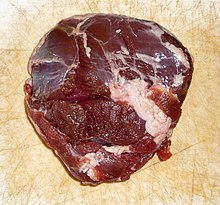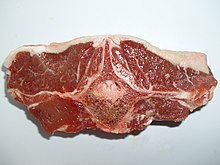
Back Skaapvleis Afrikaans لحم ضأن Arabic Qoyun əti Azerbaijani Һарыҡ ите Bashkir Бараніна Byelorussian Carn d'ovella Catalan Skopové maso Czech Carne de oveja Spanish Ardiki Basque گوشت گوسفند Persian


Lamb and mutton, collectively sheep meat (or sheepmeat) is one of the most common meats around the world, taken from the domestic sheep, Ovis aries, and generally divided into lamb, from sheep in their first year, hogget, from sheep in their second, and mutton, from older sheep. Generally, "hogget" and "sheep meat" are not used by consumers outside Norway, New Zealand, South Africa, Scotland, and Australia. Hogget has become more common in England, particularly in the North (Lancashire and Yorkshire) often in association with rare breed and organic farming.
In South Asian and Caribbean cuisine, "mutton" often means goat meat.[1][2][3][4][5] At various times and places, "mutton" or "goat mutton" has occasionally been used to mean goat meat.[1]
Lamb is the most expensive of the three types, and in recent decades, sheep meat has increasingly only been retailed as "lamb", sometimes stretching the accepted distinctions given above. The stronger-tasting mutton is now hard to find in many areas, despite the efforts of the Mutton Renaissance Campaign in the UK. In Australia, the term prime lamb is often used to refer to lambs raised for meat.[6] Other languages, such as French, Spanish, and Italian, make similar or even more detailed distinctions among sheep meats by age and sometimes by sex and diet—for example, lechazo in Spanish refers to meat from milk-fed (unweaned) lambs.
- ^ a b Oxford English Dictionary, 3rd edition, June 2003, [https://www.oed.com/view/Entry/124371 s.v., definition 1b
- ^ "Whose goat is it anyway?". Hindustan Times. 11 February 2012. Retrieved 15 May 2015.
- ^ Charmaine O'Brien, The Penguin Food Guide to India, section "The Commons", under "Mutton", ISBN 9780143414568
- ^ Madhur Jaffrey, An Invitation to Indian Cooking, ISBN 0375712119, p. 49
- ^ Janet Groene, Gordon Groene, U.S. Caribbean Guide, 1998, ISBN 1883323878 p. 81
- ^ Australian Prime Lamb Industry, 2000 Archived 13 April 2011 at the Wayback Machine